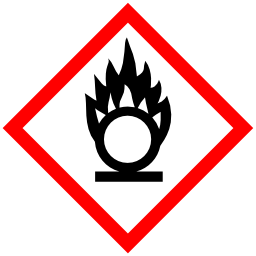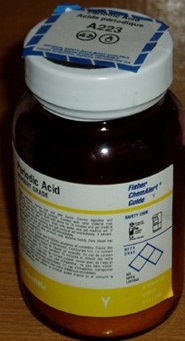Background and Overview of Hazards
Oxidizers are solids, liquids, or gases that react readily with most organic material or reducing agents with no energy input. Oxidizers are a severe fire hazard. They are not necessarily combustible, but they can intensify combustion and increase the flammable range for chemicals so they ignite more readily.
The potassium chlorate and sugar demonstration shows the energetic reaction between an oxidizer and organic compound.
Oxidizers are often recognized by a pictogram (ring on fire) or by a yellow band (containers from Fisher Scientific) on the container’s label. Keep in mind that older bottles or bottles from certain manufacturers may not have the symbol or yellow band present. It is important to be able to identify oxidizers based on their chemical name or by reading the Safety Data Sheet.


Oxidizers have different strengths. Section 2 of the Safety Data Sheet will contain one of the following GHS statements:
- H270 May cause or intensify fire; oxidizer
- H271 May cause fire or exposion; strong oxidizer
- H272 May intensify fire; oxidizer
Some of the most common oxidizers are:
Bromine | Nitric acid |
Bromates | Perborates |
Chlorates | Perchlorates |
Chromates | Perchloric acid |
Dichromates | Periodates |
Hydroperoxides | Permanganate |
Hypochlorites | Peroxides |
Inorganic peroxides | Peroxyacids |
Nitrates | Persulfates |
Nitrites |
|
Nitric acid and perchloric acid are strong oxidizers as well as corrosive. See the DRS guidance document on Mineral Acids or Perchloric Acid for more information on oxidizing acids.
Some oxidizers are highly toxic and have chronic health effects (e.g. potassium dichromate and chromic acid).
Safe Handling
- When handling strong oxidizers, at a minimum wear standard laboratory attire: closed-toe shoes, long pants, a lab coat, safety glasses with side shields or splash goggles, and gloves.
- When the procedure requires mixing of a strong oxidizer with an organic chemical, seek more specific information on the reactivity of the particular chemicals. The mixing can result in a violent reaction.
- Use oxidizers in a chemical fume hood. If there is a risk of explosion or violent reaction, it is absolutely necessary to use the hood sash as a protective barrier between you and the hazard.
- Do not return excess chemical to its original container. Contamination of the material could cause an unwanted and dangerous reaction.
Emergency Procedures
Skin Contact: Remove contaminated clothing and rinse the affected skin immediately with copious amounts of water for 15 minutes or until pain is relieved. Seek medical attention if the skin is irritated or pain is felt or if the chemical is highly toxic.
Eye Contact: Use the eye wash to rinse the eye thoroughly for at least 15 minutes, occasionally lifting upper and lower eyelids and rolling the eyeballs. Seek medical attention.
Inhalation: Move into fresh air immediately. Seek medical attention.
Ingestion: Do not induce vomiting. Rinse the mouth with water. Seek medical attention.
Provide the medical team with the Safety Data Sheet SDS for the chemical.
Always consult with the SDS for emergency procedures specific to the chemical you are using.
Spills: Sweep up spills of solid oxidizers carefully with a broom and dustpan. Collect the material in a container with lid.
Liquid spills can be cleaned up with inert absorbent pads (no organic material). If the liquid oxidizer is an acid, the spill should first be neutralized with sodium bicarbonate. See the DRS guidance document on Mineral Acids or Perchloric Acid for more information on oxidizing acids.
Storage
Separate oxidizers from organic chemicals, reducing agents, and combustible materials by using secondary containment or storing them on different shelves. Store them away from heat sources.
Waste Disposal
Keep waste streams containing oxidizers separate from organic waste and waste containing reducing agents.
Accidental mixing of oxidizers and organics in closed waste containers has caused several accidents in recent history. Be extremely careful when labeling and filling waste containers.